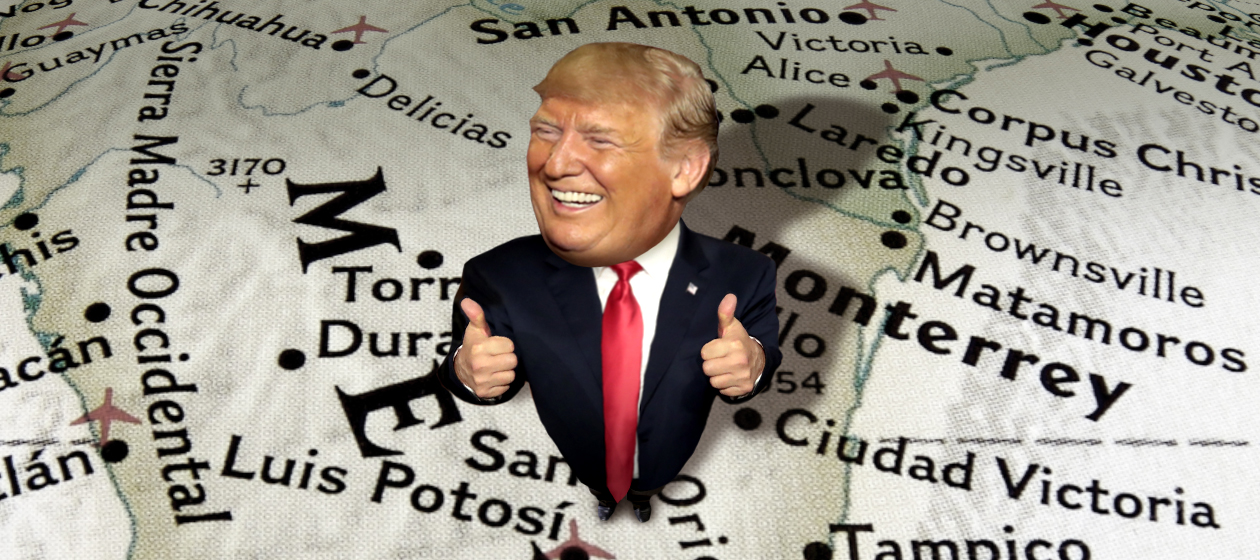Trump's NAFTA stunt
The president isn't rewriting NAFTA. He's just renaming it.


Has President Trump gotten his NAFTA deal?
After months of inconclusive negotiations, Trump announced Monday that the U.S. and Mexico have ironed out their major disagreements over the North American Free Trade Agreement. Without getting into the specifics, the president said the new bilateral agreement — which notably does not include Canada, the third signatory of NAFTA — is "elegant" and "very special" for farmers and manufacturers. He seemed most concerned, however, with the name itself. "We are going to call it the United States-Mexico Trade Agreement, and we will get rid of the name NAFTA," Trump said. "It has a bad connotation because the United States was hurt very badly by NAFTA."
This is key. Trump is nothing if not a master brander, and there's a good chance that a rebranding exercise is all this will be.
The Week
Escape your echo chamber. Get the facts behind the news, plus analysis from multiple perspectives.

Sign up for The Week's Free Newsletters
From our morning news briefing to a weekly Good News Newsletter, get the best of The Week delivered directly to your inbox.
From our morning news briefing to a weekly Good News Newsletter, get the best of The Week delivered directly to your inbox.
The big criticism of NAFTA is that it wiped out American jobs — as many as 600,000 of them over two decades, one progressive critique found. (And though Trump is unlikely to care, it's worth mentioning that NAFTA also likely destroyed the livelihoods of over a million small farmers in Mexico.) So the key question over changing NAFTA has always been whether a revamped agreement can bring those American jobs back.
The details that have leaked out so far don't suggest a thundering "yes."
Many of the changes America and Mexico agreed to are uncontroversial updates meant to bring NAFTA's language into the digital age. The internet — with all its attendant trade issues around copyrights for digital media or internet services that cross national borders — largely didn't exist yet in 1994, so this would probably have happened no matter what.
The stuff that's given negotiators heartburn is more specific and largely focused on the auto industry. There's a new requirement that automakers manufacture 75 percent of their cars in North America to avoid tariffs — an increase from 62.5 percent. They'll have to use more local steel and aluminum and other parts, and rely more heavily on workers making at least $16 an hour. Finally, cars and trucks from Mexican plants that don't meet these requirements will face a 2.5 percent tariff.
A free daily email with the biggest news stories of the day – and the best features from TheWeek.com
Obviously, these changes aren't nothing. But they're just tweaks to the original deal and not remotely commensurate to the problem.
Take the agreement's disproportionate focus on the automotive industry. Between 1994 and 2017, auto-manufacturing jobs in the U.S. fell by 350,000. That's a lot, but you can't blame NAFTA for all of them. There was also the strong dollar regime instituted under President Clinton, the expansion of World Trade Organization membership, and more. But even if you did blame NAFTA for all those lost jobs — which, again, is wildly implausible — it would still only account for less than 60 percent of the agreement's total damage. Where's the new deal's solution to the other 250,000 jobs? There's more to American manufacturing than cars.
Then there's question of whether this middling deal can even get ratified. Trump might, of course, surprise us, but it doesn't look promising.
Let's start with Canada. Any new NAFTA deal requires its sign-off as well — and it doesn't seem happy at the moment.
Trump has done nothing to ease tensions with our northern neighbor on a whole range of trade issues. Canada actually dropped out of negotiations entirely over the last five weeks, which allowed America and Mexico to hash out their differences, but also left unresolved a host of issues involving all three countries.
In particular, there's the Trump administration's demand that the renegotiated trade deal include a sunset provision: Every five years, the new NAFTA would automatically end unless the three parties got together to renew it. This is actually a perfectly reasonable ask. But Canada is balking. And even if Trump can get some version of the sunset provision, that just gets us back to the questions raised above: What more can this White House or a future one get out of Canada and Mexico? And how much can alterations to NAFTA alone really do to resurrect American manufacturing?
They're also short on time: Andrés Manuel López Obrador, a populist with his own long list of beefs with NAFTA, will become Mexico's president on Dec. 1. If he enters office before this new version of NAFTA is finalized, everyone will probably have to go back to the drawing board. And according to the rules, even after American, Mexican, and Canadian negotiators have sorted everything out, Congress still needs a three-month lead time to sign off. That gives the U.S. and Mexico until the end of August — mere days away — to get Canada on board.
Then there's the complicated domestic politics. For all of Trump's bluster, he's never had the unilateral power to "cancel" NAFTA. Yes, as the executive, he could declare the agreement itself dead. But NAFTA isn't just the treaty, it's also the domestic laws Congress passed to enforce it. Getting rid of those would require a vote in the legislature, and the chances that Trump could round up the necessary majorities are slim, to put it kindly. Meanwhile, ending the agreement but not the implementing law would plunge the U.S. into a whole morass of violations with the rest of the World Trade Organization.
The dirty secret of Trump's whole anti-NAFTA crusade is that he's actually bargaining from an incredibly weak position. A mere rebranding stunt is probably the best he could've hoped for.
Jeff Spross was the economics and business correspondent at TheWeek.com. He was previously a reporter at ThinkProgress.
-
 ‘Consistency at the ballot box isn’t nearly as meaningful to many voters here’
‘Consistency at the ballot box isn’t nearly as meaningful to many voters here’Instant Opinion Opinion, comment and editorials of the day
-
 8 musicals to see this winter, all across the United States
8 musicals to see this winter, all across the United Statesthe week recommends New shows and reconsidered productions are on the move
-
 Rob Reiner, wife dead in ‘apparent homicide’
Rob Reiner, wife dead in ‘apparent homicide’speed read The Reiners, found in their Los Angeles home, ‘had injuries consistent with being stabbed’
-
 Has Zohran Mamdani shown the Democrats how to win again?
Has Zohran Mamdani shown the Democrats how to win again?Today’s Big Question New York City mayoral election touted as victory for left-wing populists but moderate centrist wins elsewhere present more complex path for Democratic Party
-
 Millions turn out for anti-Trump ‘No Kings’ rallies
Millions turn out for anti-Trump ‘No Kings’ ralliesSpeed Read An estimated 7 million people participated, 2 million more than at the first ‘No Kings’ protest in June
-
 Ghislaine Maxwell: angling for a Trump pardon
Ghislaine Maxwell: angling for a Trump pardonTalking Point Convicted sex trafficker's testimony could shed new light on president's links to Jeffrey Epstein
-
 The last words and final moments of 40 presidents
The last words and final moments of 40 presidentsThe Explainer Some are eloquent quotes worthy of the holders of the highest office in the nation, and others... aren't
-
 The JFK files: the truth at last?
The JFK files: the truth at last?In The Spotlight More than 64,000 previously classified documents relating the 1963 assassination of John F. Kennedy have been released by the Trump administration
-
 'Seriously, not literally': how should the world take Donald Trump?
'Seriously, not literally': how should the world take Donald Trump?Today's big question White House rhetoric and reality look likely to become increasingly blurred
-
 Will Trump's 'madman' strategy pay off?
Will Trump's 'madman' strategy pay off?Today's Big Question Incoming US president likes to seem unpredictable but, this time round, world leaders could be wise to his playbook
-
 Democrats vs. Republicans: who are US billionaires backing?
Democrats vs. Republicans: who are US billionaires backing?The Explainer Younger tech titans join 'boys' club throwing money and support' behind President Trump, while older plutocrats quietly rebuke new administration
